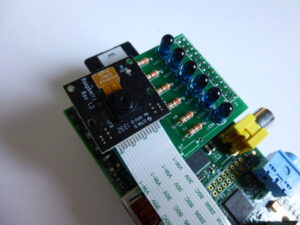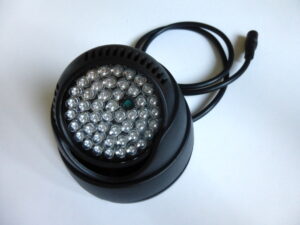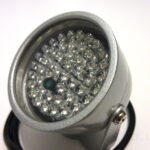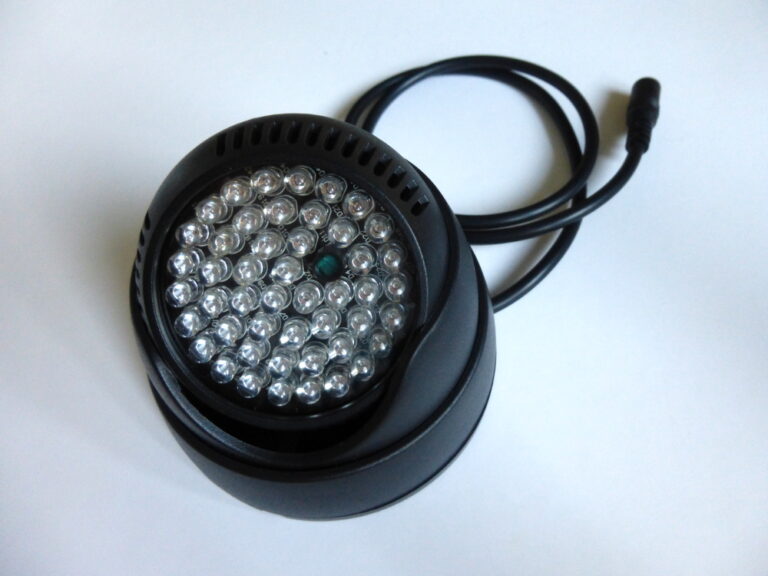As soon as I ordered some Pi NoIR camera modules I also ordered some bits and pieces for testing. This included some standard IR LEDs and a couple of cheap IR CCTV illuminators.
These would allow me to test with the camera module and work out what sort of IR lighting I needed for different applications. Ideally I was looking for suitable lighting for an outdoor security camera and I wanted to workout if it would be easier to use ready made lights or make my own.
In the example shots below I used raspistill with default settings. i.e.
raspistill -o ir_test.jpg
 Modified BerryClip
Modified BerryClip
To start with I decided to try some standard IR LEDs and to simplify the wiring I used a BerryClip PCB to mount six of them.
The LEDs were 5mm Kingbright LEDs with an emitted wavelength of 940nM.
The BerryClip board (~£6) connects the LEDs (~£2.50) to GPIO pins via 330ohm resistors. This limited the current to each LED to approximately 5mA, way below their 50mA rating. I turned them all on using a simple Python script based on one of the standard BerryClip examples.
Here are the results :
The intensity and range were quite limited and objects more than 1 metre from the camera disappeared into the darkness. I suspect this was due to not driving them with enough current and I would expect better results if I made a custom board where I didn’t need to drive the LEDs from the GPIO pins. Although these shots have a certain style to them and this may be exactly what you are after!
 48 LED IR Illuminator
48 LED IR Illuminator
Next up was the 48 LED CCTV illuminator I ordered on eBay (~£6). It needed 12V but produced much more light. It easily illuminated my office and if pointed directly at the Pi NoIR resulted in a completely white photo! I could position it almost anywhere in the room and the reflected light still gave good images.
The LEDs have a very faint red glow to them when on.
Here are a few test shots :
I really like the black eyes I appear to have. Very Blair Witch.

I also bought a few metal cased illuminators. These are very similar to the black plastic one above but are weatherproof. The light output was very similar and it produced similar test photos.
So for my purposes I think the CCTV illuminators will suit me better. The ones I ordered aren’t really suitable for outdoor use but I will give them a bit of shelter while I do some testing. If that goes OK I can replace with slightly more robust versions.
As you can see from the test shots the lighting you may need for your project will depend on the results you are after. If you are looking to light up a bird box then you almost certainly want to consider using a handful of IR LEDs.
Given you can’t see Infrared I did a quick Google to see if these sort of lamps have any health dangers. There don’t seem to be any major concerns but I would use a bit of cautious common sense and avoid staring directly at IR sources. Your eyes can’t see the IR so your pupils won’t react to intense levels as they would do for visible light. They seem to be considered safe but a bit of over-cautious paranoia where your eyes are concerned is no bad thing.
The Pi NoIR camera module is now available from all the usual online Pi accessory shops.








17 Comments
Hi Matt.
Interesting experiments. If you took the resistors out and directly connected the LEDs to the full current, would that work?
—
Mike
I could change the resistor values but I didn’t want to draw too much current directly from the GPIO pins. My next step will be to make a strip board circuit and give the LEDs 40-50mA direct from the 5v supply.
Very cool, thanks for sharing.
Very nice!
Have you already made some ir pictures with false colors to show heat e.g. mainboard of a running computer/laptop or a person?
Unfortunately the Pi-NoIR camera is not sensitive to long-wavelength IR so can’t be used to detect heat.
Thanks for posting your findings. I’ve managed to get my own night cam up and running using this. I’m still waiting for my IR LEDs from China, as it’s not exactly useful at present in low light!
I’ve had it streaming for over 24 hours without dropping, and I’ve been absolutely amazed by its performance over the web.
I’m looking to use this as a baby monitor so I’d be really interested to know if there is any way to get that latency down at all.
This is great info, so thanks for posting it.
I was wondering if the LED’s or the illuminator produced any visible light at all?
The illuminator LEDs give a very faint pin-prick of red light. It’s very faint and not enough to light anything up.
How did you powered 12V to the IR Illuminator ?
The illuminators have DC female sockets on them. I just used a spare 12V power supply with a DC barrel jack that fitted.
Hi Matt,
Many Thanks for your explanations, it was exactly what I was searching, it helps me a lot. will try to see, if a power illuminator USB powered exists so I can also connect it to the USB hub dedicated to the raspberry pi.
Best Regard,
Chris
Was thinking about buying a USB powered desk light and replacing the LEDs with IR LEDs.
Would this work?
Possibly. IR LEDS usually drop a different voltage to standard LEDs so they may or may not work depending on the electronics in the lamp. Probably cheaper to just wire together a bunch of IR LEDs, with resistors and a suitable power supply.
Do you already have a result of running the LEDs on 5V and how this affects the brightnes of the IR light?
I had ordered a pi camera kit on amazon. It comes with 2 huge ir LEDs, or actually, 2 ir LEDs that has some kind of white screen projector. The camera can’t even view beyond the patio at night time. So I am looking for an ir illuminator. But, I gotta say, as stock 2 ir led, the camera took very well pics in a low lit room vs my phone camera.
I mostly look for the quantity of LEDs. I have a broken Foscam that contains about 56 LEDs and it has lit very well to across the street to my neighbor house. But the problem was placement around bushes/trees. Because nearby branches would shine back bright white and make just a little glow effect. I would still love to have 56 LED but I will except 40+. I won’t go below that.
Very interesting. I wondered if you had tried using multiple illuminators with different IR e.g. 850 + 940 nm wavelengths at the same time ? Would you get any colour differentiation in the raw image ? If (as I suspect) not, would it be possible to get a Raspberry Pi to use the two wavelengths on alternate image frames and combine them in false colour ? As with visible light, two IR wavelengths should provide more information than using a single wavelength.
This is a very informative post, thanks.
I just wanted to add one thing: I’ve been using the same black IR light for about a year now with a baby cam in my kids room (2 weeks until his 1st b-day, so yeah, about a year lol). 48-LEDs, about $7 on ebay, cheapest I’ve seen and it did/does work great!
The only thing that might be worth mentioning is the LEDs go out pretty quickly on it. If I had to guess, I would say that out of the 48 LEDs, about 15 are working still. It still illuminates his crib well enough (in fact the 48 were maybe too bright, washed out some of the picture with bright white light), but for the price I’m actually about to pick up another one. I might just get two so I can replace it in a year again lol.